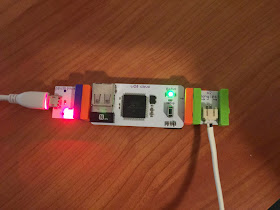littleBits Overview
Recently I received a littleBits CloudBit starter pack as a holiday gift. For those of you who don't know what littleBits are you check them out here: http://littlebits.cc/ I like to think of them as LEGO's for IoT. I have played with Arduino and a few other maker packs but they all have a pretty steep learning curve. For example, to get my Arduino setup to talk to the cloud I had to setup a Node.JS server on my local mac, program an Arduino Sketch, and mess around with a breadboard breaking multiple transistors along the way. I have shaky hands! I like Arduino but I wanted something that was a little easier to play with. Enter littleBits.
Whereas LEGO's have interlocking blocks, littleBits have interlocking components via tiny magnets. There are several types of littleBits that you snap together to form electronic circuits (power, inputs, outputs, and wires). Below is the very simple circuit I built for this demo. It has only 3 blocks. The USB Power, the CloudBit, and a LED Light.
This makes it super simple to create IoT devices. The cloud module I have also automatically syncs to the littleBits cloud and has REST API access, as well as IFTTT connectors. I wanted more granular control over my integration so I chose to call the CloudBit API directly via REST instead of the IFTTT connectors available.
So the first thing I wanted to do was set this up to work with the Salesforce1 Platform.
Pre-Requisites
1. Salesforce1 Developer Login (Free, Sign Up Here)
2. littleBits CloudKit ($100 US, Here)
3. Setup your littleBits Cloud Account via the CloudBit instructions.
Salesforce Setup
Once you have setup the your littleBit cloud account and done the first tutorial that show you how to set it up, you are ready to move on to calling your device from other cloud platforms via the littleBits Cloud HTTP API. From Salesforce.com we will be using APEX HTTP Callouts to send JSON payloads to our littleBit CloudKit device.
Step 1: Setup the Remote Site
In Salesforce.com Setup navigate to "Remote Site Settings" and create a Remote Site Setting with the remote site url of: https://api-http.littlebitscloud.cc
Once the Remote Site Setting is configured we can work on creating our Apex Class.
Step 2: Create the Apex Class "LittleBitsManager".
Using the Developer Console or the Force.com IDE, create the following simple Apex Class. You will replace XXXXX in the URL with your Device ID and xxxxxxxxxxxxxx in the Authorization Header with the Authorization Token in your littleBits cloud setup.
public class LittleBitsManager
{
//If we want to make a callout to littleBits from a Trigger, we have to do it Asynchronoushly.
@future(callout=true) //callout = true allows HTTP Callout from Apex in Async Context
public static void sendOutputReqAsync(integer percent, integer duration)
{
LittleBitsManager.sendOutputReq(new LittleBitsOutputPayload(percent,duration));
}
//This method will callout to the littleBits Cloud Device
public static void sendOutputReq(LittleBitsOutputPayload outputPayload)
{
HttpRequest req = new HttpRequest();
//Set HTTPRequest Method
req.setMethod('POST');
//Set HTTPRequest header properties, littleBits takes JSON payloads and is RESTful
req.setHeader('content-type', 'application/json');
//Set the Endpoint (You should make this a Custom Setting but hard coding for example)
req.setEndpoint('https://api-http.littlebitscloud.cc/v2/devices/xxxxxxxxxxxx/output');
req.setHeader('Authorization','Bearer xxxxxxxxxxxxxxxx');
//Set the HTTPRequest body
//req.setBody('{"percent":100, "duration_ms":3000}');
req.setBody(JSON.serialize(outputPayload));
Http http = new Http();
try {
//Execute web service call here
HTTPResponse res = http.send(req);
//Helpful debug messages
System.debug(res.toString());
System.debug('STATUS:'+res.getStatus());
System.debug('STATUS_CODE:'+res.getStatusCode());
} catch(System.CalloutException e) {
//Exception handling goes here....
}
}
//Request Payload in Apex to hold the values we are sending to littleBits.
public class LittleBitsOutputPayload
{
//Percent is the amount of output voltage you want to send from 0 to 100% as an integer
public integer percent {get;set;}
//Duration is the time you want to set the voltage. 3000 milliseconds is the default as specified in API docs.
public integer duration_ms {get;set;}
public LittleBitsOutputPayload(integer inputPercent, integer inputDuration)
{
this.percent = inputPercent;
this.duration_ms = inputDuration;
}
}
}
Step 3 - Invoke the LittleBitsManager Apex Class from a Apex Trigger
This simple Apex Trigger will invoke the littleBits Cloud Asynchronously via the above Apex code. Our simple use case is when someone closes an opportunity in Salesforce we should light up an LED.
trigger OpportunityTrigger on Opportunity (after update)
{
//Always put this logic in a Trigger Handler never in trigger code
//For example for littleBits this will be ok
for(Opportunity oppty : trigger.new)
{
//If an Opportunity has a been moved to a stage of Closed Won let the team know! Light up the Board via littleBits
if(oppty.Stage == 'Closed Won' && trigger.oldMap.get(oppty.ID).Stage != 'Closed Won')
{
LittleBitsManager.sendOutputReqAsync(100,10000); //100% Power, 10 Seconds (10,000 milliseconds)
}
}
}
Step 3 - Test it Out
Here is a simple demonstration showing everything running together. When the Apex Trigger fires the call is made to the CloudBit to light up for 10 seconds. This is a very simple use case but shows how simple it is to get the "plumbing" working between the two platforms. With 100's of different cloudbit connectors and the flexible platform of Salesforce 1 you can literally build any type of IoT application you can think of rapidly!
Note: Reid Carlberg from the Salesforce.com Evangelist team already did a very similar setup here where he uses IFTTT and Twillio / SMS to activate a CloudBit. If you want to see how to use IFTTT and not code directly against the CloudBit API it's worth a view! (https://www.youtube.com/watch?v=Pa9QrwEhuSA)

